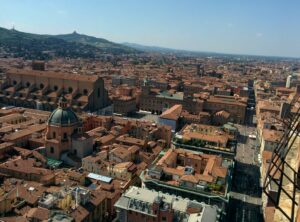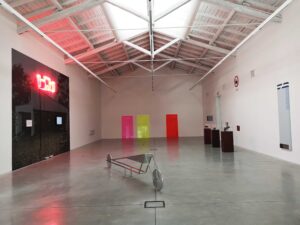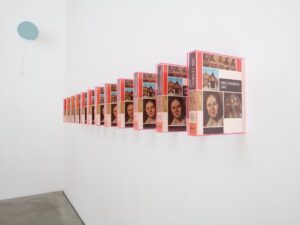 In a first part we presented four exhibitions in Bologna, which were inaugurated shortly before or on the day of the contemporary (Giornata del Contemporaneo) on Saturday 7th October. Subsequently, we will introduce you to four further shows, all opened for this special occasion. They will all be visible for the next weeks, two of them even until January.
In a first part we presented four exhibitions in Bologna, which were inaugurated shortly before or on the day of the contemporary (Giornata del Contemporaneo) on Saturday 7th October. Subsequently, we will introduce you to four further shows, all opened for this special occasion. They will all be visible for the next weeks, two of them even until January.
Labs Gallery: Claudio Verna – Beautiful Life
Otto Gallery: Stazionari Altrove (group exhibition)
Galleria Studio G7: Jacopo Mazzonelli – A Room
Galleria Enrico Astuni: L’opera d’arte parla (group exhibition)
Claudio Verna – Beautiful Life
Labs Contemporary Art
www.labsgallery.it
7 October – 2 December 2023
Claudio Verna, experienced analytical painter, has his first solo exhibition in the Labs gallery. Even though it is not a broad retrospective of his oeuvre, his long-lasting investigation about the possibilities of painting by painting is evident. Therefore, the curator David Ferri has juxtaposed two pictures of the 1970s to several from the 2000s.
“A 88” from 1971 is a white painted canvas with a fine red rectangular grid. In the resulting squares is again a grid, but this time it is in yellow and the delicate lines are irregularly interrupted. Like the colours, the motif of the grid is recurring: “Campo di segni” (2019) readopts the grid and the yellow and red tones of the older image. However, the quasi monochromy does not emerge from white, but from the mentioned warmer shades. In opposite to the older painting, the squares are not filled with geometric forms. Here there are irregular fan-like brushstrokes, which could refer to the interrupted inner lines of the former picture and show at the same time, that the painting is a painting.
Even in absence of Claudio Verna’s images between 1976 and 2009, they are recalled by the less geometric character and the bright colours in the presented works. These yellow/orange shades are repeated in other paintings like “Fuoco di mezzogiorno”, “La miettitura” (both 2019) and “Transiti 1” (2013). Additionally, reminiscences of the warm tones are reflected in the title giving “Beautiful Life” (2017). This quasi-monochrome white image incorporates light yellow to brown strokes and scratches. It is almost as if the grid from 1971 is decomposed to show more the character of a painting.Moreover, also the geometric element of “Pittura” (1976), a rectangular bar (or in this case two bars) is recurring. It is manifest in “Andante appassionato” (2012) and “Bone black” (2009). Thus, a small selection of the recent works by Claudio Verna confronted by two significant early works somehow generates a review of a big part of the artist’s oeuvre.
Stazionari AltroveLoris Cecchini, Matteo Montani, Vincenzo Schillaci, Marco Tirelli
Otto Gallery
www.otto-gallery.it
7 October – 15 December 2023
With the group exhibition “Stazionari Altrove”, the Otto Gallery unites four artists born between 1956 and 1984. Hence, they are coming from different generations and herewith diverse backgrounds. The idea for this show arises from one of the artists, Matteo Montani, who also curated it. He asks the question of the relation between art and nature.
Regarding the works, one might think at first glance: Ah! The artists illustrate natural phenomena. But this is only half of the truth. There is also the question behind: Which kind of power provokes the artist to create an artwork that establishes a relation between the eye of the contemplator and the surrounding world? It is a search for this transcendent element, which is part of the world like the forces of nature. The exhibition doesn’t want to give a simple answer but likes to encourage the consideration of this question.
Nevertheless, several artworks seem to deal with natural subjects like the desert (Loris Cecchini: Aeolian Landforms (Arzenga), 2023), landscapes (Marco Tirelli: Senza titolo, 2021), the human body (Marco Tirelli: Senza titolo, 2023), clouds, wind and rain (Matteo Montani: Sulla melodia delle cose, 2022, Stazionari Altrove, 2023). Nevertheless, the works are much more than a simple reproduction. The attribution to natural phenomena is only possible, because the contemplator could recognise and associate subjects, since the human brain concludes and assembles elements to a picture. However, what is the relief of waves in sand colours? Not necessarily a desert. This becomes evident, if the waves are coloured in red (Loris Cecchini: Aeolian Landforms, 2022). Trickier is it, if the present picture is an accumulation of colours like in Vincenzo Schillaci’s phantasms. Even without recognition of something specific one might appreciate the artwork. Here, the power of artistic creation appears evidently, like in other artworks.
Jacopo Mazzonelli – A RoomGalleria Studio G7
https://galleriastudiog7.it
7 October 2023 – 6 January 2024
For the exhibition “A Room” Jacopo Mazzonelli has created a kind of silent sound space. To this, he disassembled musical instruments, clocks and typewriters, in order to assemble them to visual expressions of sound. For example, a representation for the sound of piano music is the “Antipiano”. Here, white piano keys are arranged in a right angle and attached to the wall.
Besides sound, time is an important element of music to specify the rhythm and to define quiet breaks. Consequently, time is the subject of several works. For “Le degré zéro” Jacopo Mazonelli positioned a typewriter ribbon between two high polished steel plates. By the reflection of the ribbon, it is extended into the infinite and herewith cancels fragmentation of time. On the contrary, “Finis” sets a rhythm, even though it remains still. Like steps arranged original rolls of a mechanical pianola seem to reflect the sound of the wall. However, they bear the word “Finis” to declare the death of the sound, the silence that occurs at the end of every piece of music. Altogether, the artist transforms music into visual objects and refers at the same time to silence and time in his “ideal room of music”.
L’opera d’arte parlaAlberto Garutti, Christian Jankowski, Jonathan Monk, Maurizio Nannucci, Gianni Piacentino, Steven Pippin
Galleria Enrico Astuni
www.galleriaastuni.net
7 October 2023 – 12 January 2024
 The title of the exhibition “The Artwork speaks” refers to a text by Helmut Friedel. Here the German art historian elucidates that artworks have their inherent language. There is no universal decryption for art. It is the challenge of the spectator to read or decipher the individual message. With the group show, the Galleria Enrico Astuni illustrates very well, how different the artistic expression can be, in uniting six artists with different approaches.
The title of the exhibition “The Artwork speaks” refers to a text by Helmut Friedel. Here the German art historian elucidates that artworks have their inherent language. There is no universal decryption for art. It is the challenge of the spectator to read or decipher the individual message. With the group show, the Galleria Enrico Astuni illustrates very well, how different the artistic expression can be, in uniting six artists with different approaches.
Gianni Piacentino constructs vehicles and depicts means of transportation. His sculptures and paintings have a very even and technical character, which seem to express a certain distance to the subject. However, regarding his oeuvre with its recurring theme and knowing his biography, the passion for velocity is evident, even though, his vehicles have no driving ability. The photographer and installation artist Steven Pippin is also interested in mechanical engineering. Similar to Gianni Piacentino, his cameras are not operative since he added blocking elements to them.
Maurizio Nannucci’s preferred materials are neon, neon coloured Plexiglas and language. Certainly, his watchwords are decipherable. At the same time, they become – in their context of light and space – images in the sense of Helmut Friedel. Besides several other materials and techniques, Christian Jankowski also utilises neon. In his presented recent project “Luftschloss Royal – fliegender Turm” (Castle in the air – flying tower) he takes the German expression for pipe dream literally: He forms castles out of neon, which are intended to be installed at the top of buildings. Additionally, he recounts the genesis of the project in the exhibition via video. Alberto Garutti’s exposed works seem to be very simple; vases and a mirror. Despite their frugalness, they express a concept which needs to be discovered. Exemplary is “Sehnsucht” (Longing). The title refers to the keyword of German romanticism. But for what could the two angular ceramic vases be longing? For each other. Similar in colour and form, they could be assembled into one unique piece, like soulmates. Nevertheless, they are placed in separate rooms. So, they are close together and yet unattainable for each other. In his work “The Knowledge in pink” Jonathan Monk does not refer directly to the work of other artists as he often does in his oeuvre. Instead, he quotes himself. Previously, he created “The Knowledge”, where he puts twelve binder folders from the series “Discovering Art” in twelve transparent plexiglass boxes. These copies, published in England in the early 1960s, originated from his mother’s house and are a glance to the artists childhood. For the present work, he encased the folders in pink transparent plexiglass boxes, hence the title. Due to the colour, the decorative character is underlined, freely after Lawrence Weiner “books do furnish a room”.
In his work “The Knowledge in pink” Jonathan Monk does not refer directly to the work of other artists as he often does in his oeuvre. Instead, he quotes himself. Previously, he created “The Knowledge”, where he puts twelve binder folders from the series “Discovering Art” in twelve transparent plexiglass boxes. These copies, published in England in the early 1960s, originated from his mother’s house and are a glance to the artists childhood. For the present work, he encased the folders in pink transparent plexiglass boxes, hence the title. Due to the colour, the decorative character is underlined, freely after Lawrence Weiner “books do furnish a room”.











































